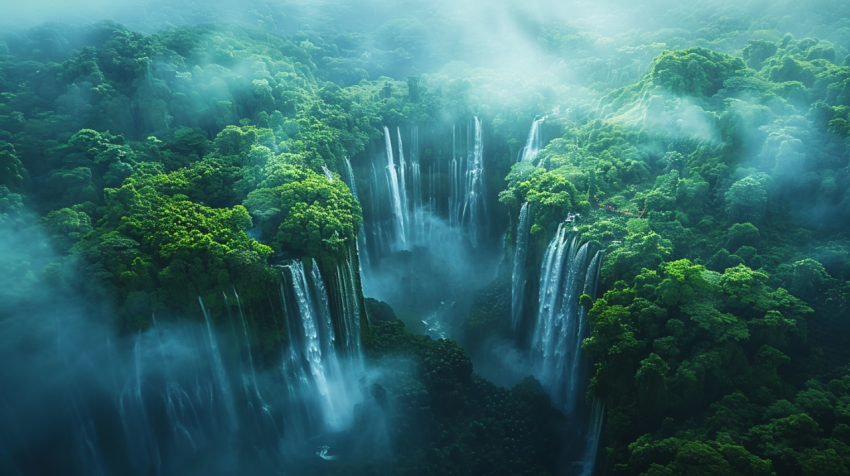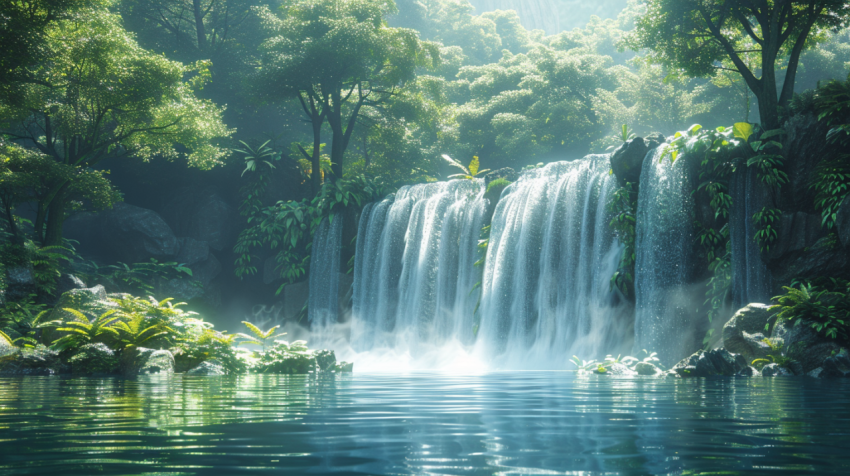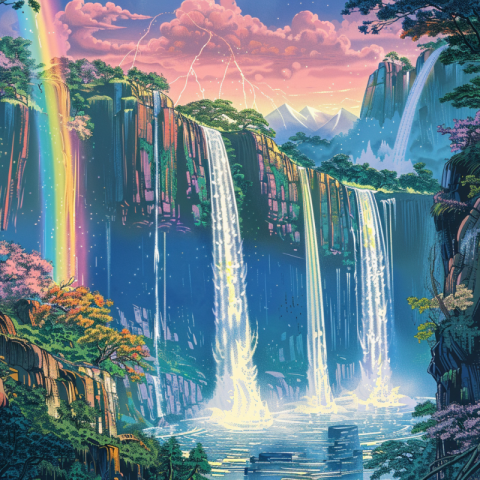











The Power and Beauty of Waterfalls: Formation, Types, and Ecology
Waterfalls are a spectacular display of nature's power and beauty, where a river or stream cascades over a steep drop, creating a mesmerizing spectacle of falling water. They range in size from small, delicate cascades to thundering torrents that plunge hundreds of feet. Waterfalls are not only visually stunning but also play an important role in shaping landscapes, creating unique microclimates, and supporting specialized ecosystems. This exploration delves into the fascinating world of waterfalls, examining their formation, different types, ecological significance, and cultural importance.
1. Formation of Waterfalls:
Waterfalls are formed through a combination of geological processes, primarily erosion:
- Differential Erosion: This is the most common cause. When a river flows over layers of rock with varying resistance to erosion, the softer rock erodes faster than the harder rock. This creates a step or cliff over which the river falls.
- Faulting: Movement along a fault line can create an abrupt change in elevation, leading to the formation of a waterfall.
- Glaciation: Glaciers can carve out deep valleys with steep sides. When the glacier retreats, it can leave behind a hanging valley, where a tributary stream plunges into the main valley below.
- Volcanic Activity: Lava flows can create cliffs and plateaus over which rivers may flow, forming waterfalls.
- Landslides: Landslides can dam rivers, creating a lake that eventually overflows and forms a waterfall.
2. Types of Waterfalls:
Waterfalls are classified based on their shape, the way the water descends, and the volume of water flow:
- Block/Sheet: Water descends from a wide stream or river, often over a wide ledge. (Example: Niagara Falls)
- Cascade: Water descends a series of rock steps.
- Cataract: A large, powerful waterfall, often with a high volume of water.
- Fan: Water spreads horizontally as it descends, resembling a fan.
- Horsetail: Descending water maintains contact with the underlying rock face most of the time. (Example: Horsetail Fall in Yosemite)
- Plunge: Water descends vertically, losing contact with the rock face. (Example: Angel Falls)
- Punchbowl: Water descends into a deep pool at the base, often resembling a punchbowl.
- Segmented: Water flow is split into distinct segments as it falls.
- Tiered/Multi-step: Water flows down a series of distinct steps or drops.
3. Waterfall Ecology:
Waterfalls create unique microclimates and habitats:
- Spray Zone: The area immediately surrounding the waterfall is characterized by high humidity, mist, and spray. This zone supports specialized plants, such as mosses, ferns, and lichens, that thrive in moist conditions.
- Plunge Pool: The pool at the base of the waterfall is often deeper and cooler than the surrounding river. It can support unique aquatic life adapted to turbulent, oxygen-rich water.
- Riparian Zone: The area along the riverbanks above and below the waterfall is influenced by the increased moisture and humidity. It often supports lush vegetation and provides habitat for various animals.
- Increased Oxygenation: The turbulence created by waterfalls increases oxygen levels in the water, which benefits aquatic organisms.
4. Plants and Animals at Waterfalls:
The unique conditions around waterfalls support specialized plant and animal life:
- Plants: Mosses, ferns, liverworts, and other moisture-loving plants thrive in the spray zone. Some plants are adapted to grow on the rock faces near the waterfall, clinging to the surface with specialized roots.
- Invertebrates: Insects, such as black flies and midges, are common near waterfalls. Their larvae often live in the fast-flowing water.
- Fish: Some fish species are adapted to the turbulent waters of plunge pools and the areas below waterfalls.
- Amphibians: Salamanders and frogs may be found in the moist environment around waterfalls.
- Birds: Birds may be attracted to waterfalls for drinking, bathing, and feeding on insects. Some, like the dipper, are specialized for foraging in fast-flowing water.
5. Cultural and Aesthetic Significance:
Waterfalls have long held cultural and aesthetic significance for humans:
- Inspiration for Art and Literature: Waterfalls have been a popular subject for paintings, poetry, and other forms of art.
- Tourism and Recreation: Waterfalls are major tourist attractions, drawing visitors from around the world. They offer opportunities for hiking, photography, and simply enjoying the beauty of nature.
- Spiritual and Religious Significance: In some cultures, waterfalls are considered sacred places or are associated with deities or spirits.
- Hydropower: Waterfalls are a source of renewable energy, harnessed through hydroelectric power plants.
6. Threats to Waterfalls:
While seemingly powerful, waterfalls and their surrounding ecosystems are vulnerable to various threats:
- Dam Construction: Dams alter river flow, often reducing or eliminating waterfalls downstream.
- Water Diversion: Diverting water for irrigation, industry, or other uses can reduce the flow over waterfalls.
- Pollution: Pollution from industrial and agricultural sources can harm water quality and affect the organisms that depend on waterfalls.
- Climate Change: Changes in precipitation patterns and increased evaporation rates can impact waterfall flow and the surrounding ecosystems.
- Tourism Impacts: High levels of tourism can lead to erosion, litter, and disturbance of wildlife.
7. Waterfall Conservation:
Protecting waterfalls and their surrounding environments involves:
- Maintaining Natural Flow Regimes: Ensuring that rivers have sufficient water flow to sustain waterfalls.
- Protecting Riparian Zones: Conserving the vegetation along riverbanks helps maintain water quality and provides habitat for wildlife.
- Managing Tourism: Implementing sustainable tourism practices to minimize the impact of visitors on waterfall ecosystems.
- Pollution Control: Reducing pollution from upstream sources to protect water quality.
Conclusion:
Waterfalls are captivating natural wonders that combine power, beauty, and ecological significance. They are formed through a variety of geological processes and create unique microclimates that support specialized plant and animal life. Waterfalls have also inspired humans for centuries, playing a role in art, culture, and recreation. Protecting these magnificent features and their surrounding ecosystems is essential for maintaining biodiversity and ensuring that future generations can continue to marvel at their splendor.
Waterfall Formation, Waterfall Types, Waterfall Ecology, Plunge Waterfall, Cascade Waterfall, Cataract, Block Waterfall, Fan Waterfall, Horsetail Waterfall, Punchbowl Waterfall, Tiered Waterfall, Erosion, Differential Erosion, Faulting, Glaciation, Volcanic Activity, Landslides, Spray Zone, Plunge Pool, Riparian Zone, Waterfall Plants, Waterfall Animals, Mosses, Ferns, Dipper, Hydropower, Tourism, Conservation, Threats to Waterfalls, Dam Construction, Water Diversion, Pollution, Climate Change, Cultural Significance, Aesthetic Value, Angel Falls, Niagara Falls, Victoria Falls, Yosemite Falls, Iguazu Falls, Kaieteur Falls, Plitvice Lakes, Waterfall Travel , Waterfall Photography, Waterfall Hiking, Waterfall Rappelling, Waterfall Safety, World's Tallest Waterfalls, Most Beautiful Waterfalls, Waterfall Sound, Mist, Rainbow, River, Stream, Cliff, Ledge, Geology, Geomorphology, Hydrology.

